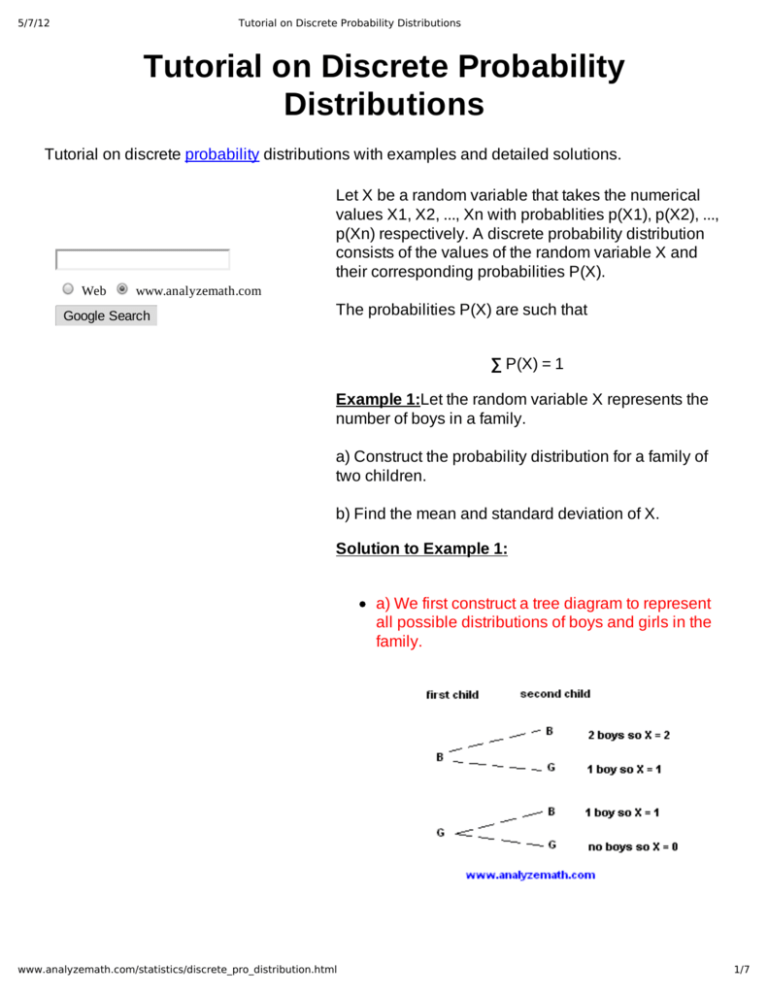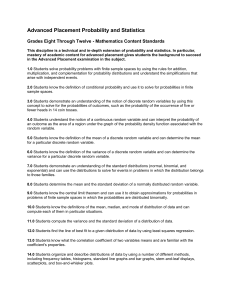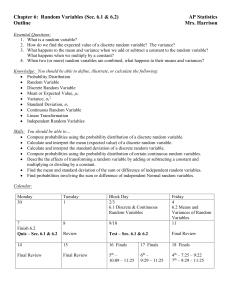
5/7/12
Tutorial on Discrete Probability Distributions
Tutorial on Discrete Probability
Distributions
Tutorial on discrete probability distributions with examples and detailed solutions.
Let X be a random variable that takes the numerical
values X1, X2, ..., Xn with probablities p(X1), p(X2), ...,
p(Xn) respectively. A discrete probability distribution
consists of the values of the random variable X and
their corresponding probabilities P(X). Web
www.analyzemath.com
Google Search
The probabilities P(X) are such that ∑ P(X) = 1
Example 1:Let the random variable X represents the
number of boys in a family. a) Construct the probability distribution for a family of
two children. b) Find the mean and standard deviation of X.
Solution to Example 1: a) We first construct a tree diagram to represent
all possible distributions of boys and girls in the
family. www.analyzemath.com/statistics/discrete_pro_distribution.html
1/7
5/7/12
Tutorial on Discrete Probability Distributions
Assuming that all the above possibilities are
equally likely, the probabilities are: P(X=2) = P(BB) = 1 / 4 P(X=1) = P(BG) + P(GB) = 1 / 4 + 1 / 4 = 1 / 2 P(X=0) = P(GG) = 1 / 4 The discrete probability distribution of X is given
by X
P(X)
0
1 / 4
1
1 / 2
2
1 / 4
Note that ∑ P(X) = 1
b) The mean µ of the random variable X is
defined by µ = ∑ X P(X)
= 0 * (1/4) + 1 * (1/2) + 2 * (1/4) = 1 The standard deviation σ of the random variable
X is defined by σ = Square Root [ ∑ (X­ µ) 2 P(X) ]
= Square Root [ (0 ­ 1) 2 * (1/4) + (1 ­ 1) 2 * (1/2) +
(2 ­ 1) 2 * (1/4) ] = 1 / square root (2)
Example 2:Two balanced dice are rolled. Let X be
the sum of the two dice. www.analyzemath.com/statistics/discrete_pro_distribution.html
2/7
5/7/12
Tutorial on Discrete Probability Distributions
a) Obtain the probability distribution of X. b) Find the mean and standard deviation of X.
Solution to Example 2: a) When the two balanced dice are rolled, there
are 36 equally likely possible outcomes as
shown below . The possible values of X are: 2, 3, 4, 5, 6, 7, 8,
9, 10, 11 and 12. The possible outcomes are equally likely hence
the probabilities P(X) are given by P(2) = P(1,1) = 1 / 36 P(3) = P(1,2) + P(2,1) = 2 / 36 = 1 / 18 P(4) = P(1,3) + P(2,2) + P(3,1) = 3 / 36 = 1 / 12 P(5) = P(1,4) + P(2,3) + P(3,2) + P(4,1) = 4 / 36 =
1 / 9 P(6) = P(1,5) + P(2,4) + P(3,3) + P(4,2) + P(5,1)=
5 / 36 P(7) = P(1,6) + P(2,5) + P(3,4) + P(4,3) + P(5,2)
+ P(6,1) = 6 / 36 = 1 / 6 P(8) = P(2,6) + P(3,5) + P(4,4) + P(5,3) + P(6,2)
= 5 / 36 P(9) = P(3,6) + P(4,5) + P(5,4) + P(6,3) = 4 / 36 =
1 / 9 P(10) = P(4,6) + P(5,5) + P(6,4) = 3 / 36 = 1 / 12 www.analyzemath.com/statistics/discrete_pro_distribution.html
3/7
5/7/12
Tutorial on Discrete Probability Distributions
P(11) = P(5,6) + P(6,5) 2 / 36 = 1 / 18 P(12) = P(6,6) = 1 / 36 The discrete probability distribution of X is given
by X
P(X)
2
1 / 36
3
1 / 18
4
1 / 12
5
1 / 9
6
5 / 36
7
1 / 6
8
5 / 36
9
1 / 9
10
1 / 12
11
1 / 18
12
1 / 36
As an exercise, check that ∑ P(X) = 1
b) The mean of X is given by µ = ∑ X P(X) = 2*(1/36)+3*(1/18)+4*(1/12)+5*(1/9)+6*(5/36) +7*(1/6)+8*(5/36)+9*(1/9)+10*(1/12)
+11*(1/18)+12*(1/36) = 7 The standard deviation of is given by µ = σ Square Root [ ∑ (X­ µ) 2 P(X) ] = Square Root [ (2­7)2*(1/36)+(3­7)2*(1/18)
+(4­7)2*(1/12)+(5­7)2*(1/9)+(6­7)2*(5/36) +(7­7)2*(1/6)+(8­7)2*(5/36)+(9­7)2*(1/9)
+(10­7)2*(1/12)+(11­7)2*(1/18)+(12­7)2*(1/36) ] = 2.41
www.analyzemath.com/statistics/discrete_pro_distribution.html
4/7
5/7/12
Tutorial on Discrete Probability Distributions
Example 3:Three coins are tossed. Let X be the
number of heads obtained. Construct a probability
distribution for X and find its mean and standard
deviation.
Solution to Example 3: The tree diagram representing all possible
outcomes when three coins are tossed is shown
below. Assuming that all three coins are indentical and
all possible outcomes are equally likely, the
probabilities are: P(X=0) = P(TTT) = 1 / 8 P(X=1) = P(HTT) + P(THT) + P(TTH) = 1 / 8 + 1 / 8 + 1 / 8 = 3 / 8 P(X=2) = P(HHT) + P(HTH) + P(THH) = 1 / 8 + 1 / 8 + 1 / 8 = 3 / 8 P(X=3) = P(HHH) = 1 / 8 The discrete probability distribution of X is given
by www.analyzemath.com/statistics/discrete_pro_distribution.html
X
P(X)
0
1 / 8
5/7
5/7/12
Tutorial on Discrete Probability Distributions
1
3 / 8
2
3 / 8
3
1 / 8
Note that ∑ P(X) = 1
We now compute the mean µ of the random
variable X as follows µ = ∑ X P(X)
= 0 * (1/8) + 1 * (3/8) + 2 * (3/8) + 3 * (1/8) = 1.5 We now compute the standard deviation σ of the
random variable X as follows σ = Square Root [ ∑ (X­ µ) 2 P(X) ]
= Square Root [ (0 ­ 1.5) 2 * (1/8) + (1 ­ 1.5) 2 *
(3/8) + (2 ­ 1.5) 2 * (3/8) + (3 ­ 1.5) 2 * (3/8) ] = 1.11
More references on elementary statistics and
probabilities.
SEARCH THIS SITE
Search
Custom Search
Home Page ­­ Algebra Questions ­­ Math Worksheets ­­ Free Compass Math tests Practice ­­ Free Practice for
SAT, ACT Math tests Precalculus Tutorials ­­ Precalculus Questions and Problems ­­ Precalculus Applets ­­ Equations, Systems and
Inequalities ­­ Online Calculators ­­ Graphing ­­ Trigonometry ­­ Trigonometry Worsheets ­­ Geometry Tutorials ­­
Geometry Calculators ­­ Geometry Worksheets ­­ Calculus Tutorials ­­ Calculus Questions ­­ Calculus Worksheets ­
www.analyzemath.com/statistics/discrete_pro_distribution.html
6/7
5/7/12
Tutorial on Discrete Probability Distributions
­ Applied Math ­­ Antennas ­­ Math Software ­­ Elementary Statistics High School Math ­­ Middle School Math ­­
Primary Math Free Math Forum Computer Technology Simply Explained Math Videos From Analyzemath Author ­ e­mail
Updated: 3 April 2011
Copyright © 2003 ­ 2011 ­ All rights reserved ­ A Dendane
www.analyzemath.com/statistics/discrete_pro_distribution.html
7/7








